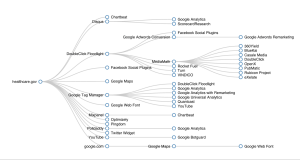 Ever since the invention of the Guggenheim press made printing available to the average person, businesses deluged consumers with traditional media — also known as outbound marketing. Now, digital media (inbound marketing) challenges the supremacy of traditional media in ways Guggenheim never imagined and produces results that stagger the imagination.
Ever since the invention of the Guggenheim press made printing available to the average person, businesses deluged consumers with traditional media — also known as outbound marketing. Now, digital media (inbound marketing) challenges the supremacy of traditional media in ways Guggenheim never imagined and produces results that stagger the imagination.
Today, I’ll share an infographic coming from my friends at Ghergich and Company, where their staffing client saw a 100% gain in organic search by using inbound marketing..
What is digital media?
Digital media refers to all types of online marketing including transforming traditional static websites into dynamic websites with high value content created on a consistent basis, social media (Facebook, Twitter, etc), email marketing, SEO (Search Engine Optimization), lead generation and nurturing, and online PR.
But, it’s not the tactics that distinguish digital media from traditional media. Instead, digital media is a paradigm shift over traditional media. Digital media relies on pull marketing while traditional media uses push marketing — and pull marketing is much more effective than push marketing.
Here’s a good explanation of push versus pull marketing from Chron:
The primary difference between push and pull marketing lies in how consumers are approached. In push marketing, the idea is to promote products by pushing them onto people. For push marketing, consider sales displays at your grocery store. On the other hand, in pull marketing, the idea is to establish a loyal following and draw consumers to the products.
Traditional media versus digital media
Traditional media uses advertising, cold calling, and direct mail virtually indiscriminately to push products on consumers who are pretty much indifferent toward their brand in the hopes of hitting the few consumers who they can convince to buy.
 Image courtesy of arstechnica
Image courtesy of arstechnica
If you think about it, traditional media’s job is to interrupt you while you’re watching TV, listening to the radio, reading, or checking your mailbox. Most of this nuisance advertising ends up in the trash or being ignored. With today’s technology, consumers find new ways to avoid interruption from advertising. They use electronic devices and online services like Netflix to avoid TV advertising — 40% of US households currently subscribe to an online streaming video service according to Nielsen and 20% of households owned a DVR device to record live TV in 2007. Based on the growth of DVR in the years before 2007, that number is likely more than 50% now. Radio advertising slumps due to ad-free options like Sirius and the increase of radio stations playing fewer commercials during drive-time. Newspapers are disappearing in a barrage of online options.
Digital media focuses on bringing in folks who need and want your brand then building a loyal following among buyers. As such, digital media is the natural progression from relationship marketing.
Traditional media just isn’t as effective as it once was. Yet, nearly 87% of media budgets remain fixed on traditional media, according to Susan Wojcicki, VP – Public Policy and Communications at Google. Notice the infographic below shows an increasing number of firms using digital marketing, but still 13+% don’t do ANY inbound marketing.
Why use digital media rather than traditional media?
Actually, there are a number of reasons for using digital media rather than traditional media:
- With appropriate analytics, it’s possible to trace ROI to specific digital media campaigns, something nearly impossible to do with most types of traditional media.
- Consumers seek out digital media while traditional media is often seen as a nuisance to be avoided.
- Digital media builds relationships with consumers who spread your message to their connections — who are likely part of your target audience because friends share commonalities.
- Peer-to-peer recommendations (word of mouth) is much more powerful in driving behavior than promoted messages.
- The ROI of digital media is much higher than the ROI of traditional media according to a big data study by Microsoft.
- Digital media builds credibility and sets the company up as an expert while traditional media hopes to buy credibility by using celebrities in their commercials.
- Digital media can reach potential customers when they’re likely to buy because they were searching for information.
ROI tracking
It’s hard to trace ROI no matter what marketing tactics you use. In traditional media, tests track changes in awareness related to an ad using aided or unaided awareness, but figuring out how much you’re selling based on an ad is nearly impossible.
Certainly, calculating the ROI of digital media isn’t easy, but firms have more tools. For instance, firms can set goals in Google Analytics to determine the ROI of online sales. Again, tracking offline sales has the same problems faced by traditional media.
Firm who can track the ROI of digital media are 12 times more likely to increase year-over-year sales.
Consumers seek digital media
Traditional media, by its very nature, is short and provides little information. In contrast, digital media provides detailed information needed to make decisions and get the most from your purchases.
 Wanna know how to turn your home into a smart house, Google it and you’ll get plenty of folks who want to help you.
Wanna know how to turn your home into a smart house, Google it and you’ll get plenty of folks who want to help you.
Wanna install a pool, but don’t know whether you should do an above ground or below ground? Google
If you’ve done a good job with SEO, folks will find you when they’re looking for information about the products you sell.
Message amplification and word of mouth
Think about your Facebook connections or Twitter followers. Likely you’ll find your connections share a lot with you. I recently attended a big data event where the presenter used R to evaluate a group of Facebook friends. Most shared similar interests, were either from the same schools or towns, and had similar professions. That makes sense because you form social connections online using similar heuristics to the ones you use in developing social connections offline.
Every time you share, like, or comment on a Facebook post or RT a Tweet, you’re offering a tacit endorsement of the brand to your connections who trust you and are similar to you — likely they need the same things you do.
As consumers, we’re more tuned into recommendations from our friends. We even pay more attention to perfect strangers than commercial messages. If you want to test this, pick a random shopper and recommend a brand from those on the shelf they’re looking at.
Higher ROI
Near the bottom of the infographic, you see the ROI of digital media for a single staffing agency. Not only did lead quality increase, but costs declined by an average of $ 1.75K. Not a bad return for digital media.
Build credibility and traffic
Blogging, especially when combined with blog promotion efforts, such as social media, email marketing, and PR, sets the firm up as an expert in their industry and lends credibility and trustworthiness to their attributes. Not only does this activity help customers along their buying journey, it brings new traffic of buying-ready customers to your website.
Recently, I’ve seen marketers question the value of a website, especially the blogging element, given so many social networks allow long form content, with Facebook being the newest social network to encourage such content.
Do you need digital media?
Personally, I’ll always see value in an owned website. Here’s my thinking:
- A website is custom branded to your firm. Branding on social networks is somewhat limited by co-branding of the social network and limitations enforced by the network.
- You maintain total control of your website. If Facebook or LinkedIn decided tomorrow they no longer wanted to host your long form content, they can wipe it out along with all the reach provided by the posts.
- Consumers tend to confuse content that’s all jumbled together as it is on a social network. On LinkedIn Pulse — their version of long form content — you’ll see one brand after another in sequence and readers often credit a brand with another brand’s content. For instance, in interviewing consumers about advertising on TV, I found they frequently thought a particular commercial was for a different brand than the one producing the commercial.
- There’s a lot of competition within long form social content. For instance, a post of LinkedIn might be preceded or followed by a post from an industry leader and name recognition often drives readers to the posts from the leader, not yours.
- Often, you want to create landing pages on your website and drive traffic to those landing pages using your long form content. On a blog, that’s easier because you can embed links, use custom buttons, and use sidebars to drive organic traffic drawn by your content to your landing pages. That’s much harder on a social network where you have more restrictions and less real estate (page dimensions).
Your turn
Of course, you’re welcome to disagree with me and I’d love to hear your thinking about traditional media versus digital media. Just post in the comments below.
Also, be sure to check out the infographic below.

Courtesy of: Akken Cloud
(252)





